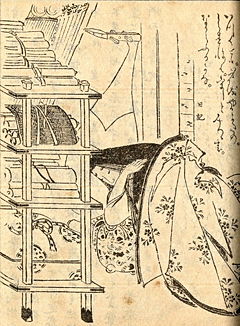Murasaki Shikibu
Murasaki Shikibu (紫式部 circa 973 – circa 1014 or 1025) was a Japanese novelist, poet, and a maid of honor of the imperial court during the Heian period. Born about 978 in Kyoto, Japan. "Murasaki Shikibu" was not her real name; her actual name is unknown, though some scholars have postulated that her given name might have been Takako (for Fujiwara Takako). Her diary states that she was nicknamed "Murasaki" ("purple wisteria blossom") at court, after a character in The Tale of Genji. "Shikibu" refers to her father's position in the Bureau of Ceremony (shikibu-shō). She was born in a family of minor nobility and a member of the northern branch of the Fujiwara clan. She either died in 1014, when records show that her father suddenly returned to Kyoto from his governor's mansion, or between 1025 and 1031, when she would have been in her mid fifties, fairly old by Heian standards.
Biography
Murasaki, or Lady Murasaki as she is sometimes known in English, is best known as the author of The Tale of Genji, written in Japanese between about 1000 and 1008, one of the earliest and most famous novels in human history.
Murasaki's mother died while she was a child, so Murasaki was raised, contrary to customs of the time, by her father Fujiwara no Tametoki, a scholar and officer of the imperial court. During Heian-era Japan, couples lived separately and children were raised by the mother and her family. Also contrary to customs of the time, her father gave her a male education. Men were educated in and taught Chinese, the official language of the court, while women were taught kana and poetry. Her father praised her intelligence and ability, but lamented that she was "born a woman". She was married in her early twenties and had one child.
At the royal court, she was the lady in waiting for Empress Shoshi/Akiko, and may have been hired by Fujiwara Michinaga to serve the Empress.
Three works are attributed to Murasaki, the most important being The Tale of Genji; The Murasaki Shikibu Diary, and The Murasaki Shikibu Collection were arranged and published posthumously. The Murasaki Shikibu Collection is a compilation of 128 poems written by Murasaki.
A fictionalized biography of Murasaki called The Tale of Murasaki: A Novel was written by Liza Dalby. A fictitious descendant of Lady Murasaki was most recently shown in the horror film Hannibal Rising
See also
- Sei Shōnagon - court rival and fellow contemporary diarist
- Ono no Takamura - an earlier Japanese poet whose grave is situated across from Lady Murasaki's
ReferencesISBN links support NWE through referral fees
- Dalby, Liza. The Tale of Murasaki: A Novel (Anchor, 2001). ISBN 0-385-49795-4.
- Lady Murasaki, Arthur Waley (trans.). The Tale of Genji, published in 6 volumes from 1921-33.
- Shikibu, Murasaki; Tyler, Royall (trans.). The Tale of Genji (Viking, 2001.) ISBN 0-670-03020-1.
External links
ar:موراساكي شيكيبو ast:Murasaki Shikibu bn:মুরাসাকি শিকিবু ca:Murasaki Shikibu cs:Murasaki Šikibu cy:Murasaki Shikibu de:Murasaki Shikibu es:Murasaki Shikibu eo:Murasaki Shikibu eu:Murasaki Shikibu fr:Murasaki Shikibu gl:Murasaki Shikibu id:Murasaki Shikibu is:Murasaki Shikibu it:Murasaki Shikibu he:מורסקי שיקיבו jv:Murasaki Shikibu mk:Мурасаки Шикибу nl:Murasaki Shikibu ja:紫式部 no:Murasaki Shikibu nds:Murasaki Shikibu pl:Murasaki Shikibu pt:Murasaki Shikibu ro:Murasaki Shikibu ru:Мурасаки Сикибу simple:Murasaki Shikibu sl:Murasaki Šikibu sh:Murasaki Shikibu sr:Мурасаки Шикибу fi:Murasaki Shikibu sv:Murasaki Shikibu uk:Мурасакі Сікібу zh-yue:紫式部 zh:紫式部
Credits
New World Encyclopedia writers and editors rewrote and completed the Wikipedia article in accordance with New World Encyclopedia standards. This article abides by terms of the Creative Commons CC-by-sa 3.0 License (CC-by-sa), which may be used and disseminated with proper attribution. Credit is due under the terms of this license that can reference both the New World Encyclopedia contributors and the selfless volunteer contributors of the Wikimedia Foundation. To cite this article click here for a list of acceptable citing formats.The history of earlier contributions by wikipedians is accessible to researchers here:
The history of this article since it was imported to New World Encyclopedia:
Note: Some restrictions may apply to use of individual images which are separately licensed.

